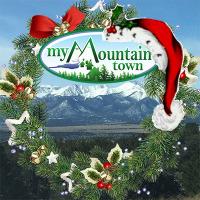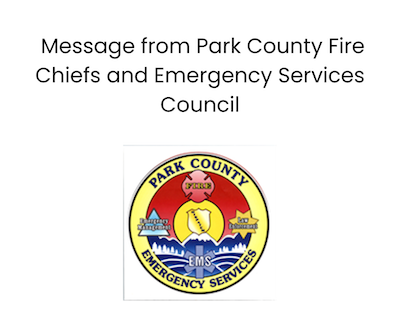- Forum
- Life Up the Hill
- Scanner & Emergency Info, Weather Forecasts
- Message from Park County Fire Chiefs and Emergency Services Council
Message from Park County Fire Chiefs and Emergency Services Council
- MyMountainTown
-
 Topic Author
Topic Author
- Mountain Champion
-

Less
More
28 Sep 2024 18:34 #1
by MyMountainTown
Posted on: September 11, 2024
Message from Park County Fire Chiefs and Emergency Services Council
As we descend into the latter half of the summer it becomes commonplace to see the various fire districts in Park County opt to enter into a burn ban. These bans can last for a specific amount of time on one day or can cover several weeks.
To the average citizen, the county wide approach may seem whimsical, but rest assured that the decision to enter into or not enter into a burn ban comes with much deliberation and is a thoughtful decision. Hopefully after reading this piece we can help allay some of the confusion that surrounds this nebulous bit of regulation.
The first critical element to understand is the red flag warning and subsequent county wide burn ban that is instituted when a red flag event is present. Park county sits in fire weather zones 212, 214, and 216. If at any point any of those zones show red flag weather is forecast for the day it triggers a county wide burn ban. This broad stroke approach was born from the need to have a streamlined system when going into a burn ban. It became too difficult for both dispatch and the Sheriff’s department to manage and enforce the laws in regards to burn bans when every district in the county was on its own page. We are aware that this approach has not always been the most popular with some residents. One reason for this frustration seems to be that this method can push a burn ban in an area that might not be experiencing the critical fire weather that neighboring areas are under threat from. Admittedly, an inconvenience.
The factors that a fire chief considers when opting to enter into a single district non-red flag burn ban rests with a few specific considerations. The first such consideration is given to fuel moistures, both live and dead. There are critical thresholds the fuels can reach, in regards to how dry they are, that make them much more receptive to carrying fire. As each district tests the moisture levels of the fuels in their area and once these critical moisture thresholds have been recorded then the communities will start to see individual fire districts enter into their own bans. Other factors that can push fire districts into a burn ban are low relative humidities, hot temperatures, and high winds for extended periods of time.
We at the various fire districts of Park County enjoy the same freedoms and benefits to living in such a wonderful place as those of you reading this piece. Your local district’s goal is never to hinder someone's “good time” or regulate in a way that alienates the fire districts from our wonderful communities. The burn ban option is one that is never taken lightly. Campfires and cookouts are arguably some of the finest elements that the summers in the Rockies have to offer. Due to these considerations, and many others, the decision to go into a burn ban is driven by empirical observations and real observed data. Opinion is removed from this decision by all agency chiefs in an attempt to implement this critical, yet sometimes inconvenient bit of regulation when necessary.
Lastly, we at the various districts throughout the county are often asked: Why are we in a burn ban if the light flashy fuels (grasses, needle litter, small twigs, etc.) are not fully cured?” The answer to this is simple as evidenced by a few small wildland fires that we’ve seen throughout Park County this summer. Green fuels can still be receptive to fire, especially if the red flag weather factors are being observed. We have witnessed a myriad of fires this year within the county that have started in fuels that are deceptively green, yet are dry enough to carry ground fire.
Thank you for taking the time to better understand the regulations in your area and learn something about the fire environment that we have all chosen to settle in. For details, please visit your local fire district website. The county website also features information about fire bans, sign up for Code Red notifications and other important information: www.parkcountyco.gov .
####
www.parkcountyco.gov/CivicAlerts.aspx?aid=1090
Message from Park County Fire Chiefs and Emergency Services Council
As we descend into the latter half of the summer it becomes commonplace to see the various fire districts in Park County opt to enter into a burn ban. These bans can last for a specific amount of time on one day or can cover several weeks.
To the average citizen, the county wide approach may seem whimsical, but rest assured that the decision to enter into or not enter into a burn ban comes with much deliberation and is a thoughtful decision. Hopefully after reading this piece we can help allay some of the confusion that surrounds this nebulous bit of regulation.
The first critical element to understand is the red flag warning and subsequent county wide burn ban that is instituted when a red flag event is present. Park county sits in fire weather zones 212, 214, and 216. If at any point any of those zones show red flag weather is forecast for the day it triggers a county wide burn ban. This broad stroke approach was born from the need to have a streamlined system when going into a burn ban. It became too difficult for both dispatch and the Sheriff’s department to manage and enforce the laws in regards to burn bans when every district in the county was on its own page. We are aware that this approach has not always been the most popular with some residents. One reason for this frustration seems to be that this method can push a burn ban in an area that might not be experiencing the critical fire weather that neighboring areas are under threat from. Admittedly, an inconvenience.
The factors that a fire chief considers when opting to enter into a single district non-red flag burn ban rests with a few specific considerations. The first such consideration is given to fuel moistures, both live and dead. There are critical thresholds the fuels can reach, in regards to how dry they are, that make them much more receptive to carrying fire. As each district tests the moisture levels of the fuels in their area and once these critical moisture thresholds have been recorded then the communities will start to see individual fire districts enter into their own bans. Other factors that can push fire districts into a burn ban are low relative humidities, hot temperatures, and high winds for extended periods of time.
We at the various fire districts of Park County enjoy the same freedoms and benefits to living in such a wonderful place as those of you reading this piece. Your local district’s goal is never to hinder someone's “good time” or regulate in a way that alienates the fire districts from our wonderful communities. The burn ban option is one that is never taken lightly. Campfires and cookouts are arguably some of the finest elements that the summers in the Rockies have to offer. Due to these considerations, and many others, the decision to go into a burn ban is driven by empirical observations and real observed data. Opinion is removed from this decision by all agency chiefs in an attempt to implement this critical, yet sometimes inconvenient bit of regulation when necessary.
Lastly, we at the various districts throughout the county are often asked: Why are we in a burn ban if the light flashy fuels (grasses, needle litter, small twigs, etc.) are not fully cured?” The answer to this is simple as evidenced by a few small wildland fires that we’ve seen throughout Park County this summer. Green fuels can still be receptive to fire, especially if the red flag weather factors are being observed. We have witnessed a myriad of fires this year within the county that have started in fuels that are deceptively green, yet are dry enough to carry ground fire.
Thank you for taking the time to better understand the regulations in your area and learn something about the fire environment that we have all chosen to settle in. For details, please visit your local fire district website. The county website also features information about fire bans, sign up for Code Red notifications and other important information: www.parkcountyco.gov .
####
www.parkcountyco.gov/CivicAlerts.aspx?aid=1090
Please Log in or Create an account to join the conversation.
- Forum
- Life Up the Hill
- Scanner & Emergency Info, Weather Forecasts
- Message from Park County Fire Chiefs and Emergency Services Council
Time to create page: 0.179 seconds






